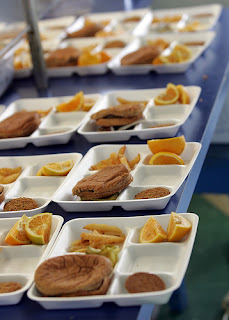So, I used to be afraid of canning because I thought it was way too complicated and required expensive materials. But after our generous neighbors gave us a water bath canner (see one
here - it only costs about $20, and it's really just a giant pot), we finally gave it a try. It turned out to be pretty easy, and a lot of fun! It made me feel like an accomplished adult, as if canning was some right of passage to adulthood. But besides that, canning is a great way to preserve food in order to have fresh, flavorful vegetables all year long.
An easy place to start is by canning whole tomatoes. They don't require a lot of preparation, and you can use whole tomatoes in all sorts of recipes. We love to use them for making pizza sauce; just dump the tomatoes, juice and all, into the pan and mash them up to make flavorful sauce.
Here's our method for canning whole tomatoes. We learned by using this
website and this
book, two great resources for canning all kinds of things.
Step 1: Buy a ton of tomatoes, or use the ones you've grown.
If you're lucky enough to have a garden, this is a great way to use up tomatoes that are becoming too ripe. If you don't have a garden, go to the farmers market in late September. Farmers often sell bulk tomatoes for really cheap, because they're trying to get rid of them. It doesn't really matter how many tomatoes you get. It just depends on how many you want canned. We bought 20 pounds of tomatoes, and it made about 15 pint-size jars of tomatoes.
 |
| bulk tomatoes bought at the farmers market |
|
|
Step 2: Sanitize your jars.
You can just put your jars in the dishwasher on the "sanitize" cycle. If you don't have a dishwasher, put the jars in boiling water. Don't put the lids in the dishwasher. Instead, dip those in boiling water before you are ready to use them. Meanwhile, fill your water bath canner halfway with water, and
start bringing it to a boil.
Step 3: Peel the tomatoes.
The quickest way to do this is to blanch the tomatoes. Get a big pot of water boiling, and drop the tomatoes a few at a time into the boiling water. Once the skins start to break, take the tomatoes out with a slotted spoon and place them in a bowl of ice water. This will stop them from cooking further. Use your hands to slide the skin off the tomato.
 |
| the tomatoes after blanching and peeling them |
Step 4: Cut the cores out of the tomatoes.
You can actually do this step before peeling the tomatoes, or afterwards. Whatever you think will be easiest. Cut out the cores (which is just the top part, near where the stem was attached) and any bruises or bad spots. You'll probably end up with some squished tomatoes, but we use those anyway.
Step 5: Put the tomatoes in the jars.
We use a slotted spoon that we have dipped in boiling water to put the tomatoes in. You can also use a funnel (which should be sanitized ahead of time). After you fill the jars, take a spoon handle and slide it around the inside edge of the jar. This will get rid of any air bubbles.
Step 6: Add lemon juice and water (if needed).
Add two tablespoons of lemon juice to all the jars. If there is still too much room at the top, add some boiling water. There should only be a half inch of space between the liquid and the top of the jar (this is called "head space"). Put the lids on the jars.
Step 7: Put the jars in the boiling water, and boil for 35 minutes.
Your water bath canner probably came with a rack that you can put the jars on so they don't touch the bottom of the pot. (This can cause the jars to break.) We use one of these fancy
jar holders to slide the jars into the boiling water. (And by "fancy," I mean they cost $5 at the hardware store.)
 |
| the filled jars in the water bath canner |
That's it! Take the jars out, and wait for them to cool. After a few hours, check to make sure the lids have sealed. You'll know because the lid won't pop back up after you push down on it. And voila, you've canned tomatoes!


































